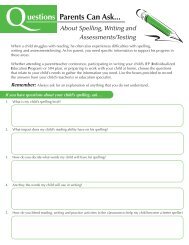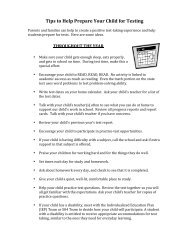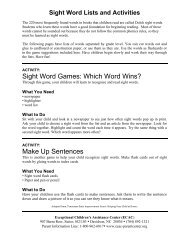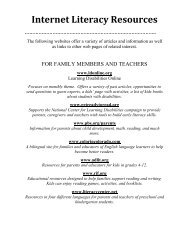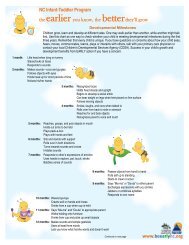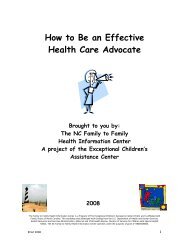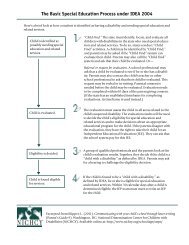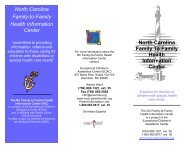Positive Student Profile.pdf - Exceptional Children's Assistance Center
Positive Student Profile.pdf - Exceptional Children's Assistance Center
Positive Student Profile.pdf - Exceptional Children's Assistance Center
Create successful ePaper yourself
Turn your PDF publications into a flip-book with our unique Google optimized e-Paper software.
<strong>Positive</strong> <strong>Student</strong> <strong>Profile</strong><br />
<br />
<br />
<br />
<br />
<br />
<br />
<br />
<br />
<br />
<br />
<br />
<br />
<br />
<br />
For more information, please contact:<br />
exceptional children's assistance center<br />
North Carolina's Parent <strong>Center</strong><br />
907 Barra Row, Suites 102/103<br />
Davidson, NC 28036<br />
800-962-6817 • www.ecac-parentcenter.org
<strong>Positive</strong> <strong>Student</strong> <strong>Profile</strong><br />
This form is to be filled out by the parent to provide a<br />
“snapshot” of your child which should be reflected in<br />
his/her IEP.<br />
Place your child’s<br />
photo here<br />
1. Who is ____________ ?<br />
(Describe your child, including information such as place in<br />
family, personality, likes and dislikes.)<br />
2. What are ____________’s strengths?<br />
(Highlight all areas which your child does well, including education and social<br />
environments.)<br />
3. What are _____________’s successes?<br />
(List all successes, no matter how small.)<br />
Adapted from: Collaborative Teams for <strong>Student</strong>s with Severe Disabilities: Integrating Therapy and Educational<br />
Services, Bevelyl Rainforth, Ph.D., P.T., Jennifer York, Ph.D., P.T., Cathy Macdonald, M.A., C.C.C./S.L.P.<br />
______________________________________________________________________________<br />
2<br />
All Children Belon
4. What are ___________’s greatest challenges?<br />
(List the areas in which your child has the greatest difficulties.)<br />
<strong>Positive</strong> <strong>Student</strong> <strong>Profile</strong> - continued<br />
5. What supports are needed for ___________?<br />
(List supports that will help your child achieve his/her potential.)<br />
6. What are our dreams for ____________?<br />
(Describe your vision for your child’s future, including both short-term and long-term goals.)<br />
7. Other helpful information.<br />
(List any pertinent information, including health care needs that have not been detailed<br />
elsewhere on the form.)<br />
Adapted from: Collaborative Teams for <strong>Student</strong>s with Severe Disabilities: Integrating Therapy and Educational<br />
Services, Beverly Rainforth, Ph.D., P.T., Jennifer York, Ph.D., P.T., Cathy Macdonald, M.A., C.C.C./S.L.P.<br />
______________________________________________________________________________________________<br />
3<br />
All Children Belong
<strong>Positive</strong> <strong>Student</strong> <strong>Profile</strong> - Brian<br />
This form is to be filled out by the parent to provide a “snapshot” of<br />
your child which should be reflected in his/her IEP.<br />
1. Who is Brian ? (Describe your child, including information<br />
such as place in family, personality, likes and dislikes.)<br />
• youngest child in the family. Jaclyn’s brother<br />
• likes to help in the kitchen<br />
• likes to read about the space shuttle and the Earth<br />
• likes to watch Reading Rainbow<br />
• favorite color is red<br />
• likes to ride his 2-wheel bike<br />
• likes to take pictures, like his dad<br />
• loves the beach<br />
• likes to go to the library<br />
• likes to play softball<br />
4<br />
<strong>Positive</strong> <strong>Student</strong> <strong>Profile</strong> - continued<br />
2. What are Brian ’s strengths? (Highlight all areas which your child does well, including<br />
education and social environments.)<br />
• imitates well<br />
• likes to help around the house<br />
• good with details<br />
• very good sense of humor<br />
• understands what is being said<br />
• sensitive to others<br />
3. What are Brian ’s successes? (List all successes, no matter how small.)<br />
• attends a first grade regular education classroom<br />
• is very good at operating a computer<br />
• calms down quickly after being upset<br />
• can make his own lunch<br />
• learning to read<br />
• has very good manners<br />
• enjoys taking cooking classes<br />
Adapted from: Collaborative Teams for <strong>Student</strong>s with Severe Disabilities: Integrating Therapy and Educational<br />
Services, Beverly Rainforth, Ph.D., P.T., Jennifer York, Ph.D., P.T., Cathy Macdonald, M.A., C.C.C./S.L.P.<br />
______________________________________________________________________________________________<br />
All Children Belong
4. What are Brian ’s greatest challenges? (List the areas in which your child has the<br />
greatest difficulties.)<br />
• inability to communicate clearly, which causes a high frustration level<br />
• dislikes unexpected change<br />
• wants to make friends but has difficulty continuing conversations<br />
• difficulty in staying on task<br />
• reluctance in doing things on demand<br />
• difficulty with Math<br />
5. What supports are needed for Brian ? (list supports that will help your child achieve<br />
his/her potential.)<br />
• to observe and learn from “typical” children<br />
• have a circle of friends<br />
• have a routine which is structured yet flexible<br />
• a curriculum which can be modified where and when needed<br />
• use of assistive technology<br />
• opportunities to be included in the community<br />
6. What are our dreams for Brian ? (Describe your vision for your child’s future, including<br />
both short-term and long-term goals.)<br />
• to have a circle of friends in his neighborhood<br />
• to learn to read and write<br />
• to expand his ability to communicate<br />
• to become independent, have meaningful employment<br />
• to be active in his community<br />
7. Other helpful information. (List any pertinent information, including health care needs, that<br />
have not been detailed elsewhere on the form.)<br />
• Due to the highly imitative skills common to children with Fragile X Syndrome,<br />
Brian needs to interact with ‘typical’ peers as much as possible. Brian’s learning<br />
style is visually oriented. He learns best through the use of incidental learning,<br />
which is using information in ways that are functional, rather than through rote<br />
learning (for example, teaching how to add by counting apples in a store as<br />
opposed to adding numbers on a page). Brian works best with short breaks<br />
between tasks. When he gets upset, it is best to try to redirect him rather<br />
than become adversarial and force compliance. Brian’s great sense of humor can<br />
be very useful at doing that. Brian has a great desire to be a part of the group<br />
and does not lie to be singled out. Therefore, a cooperative learning<br />
environment works best for him.<br />
5<br />
All Children Belong
<strong>Positive</strong> <strong>Student</strong> <strong>Profile</strong> - Christopher<br />
This form is to be filled out by the parent to provide a “snapshot” of your child<br />
which should be reflected in his/her IEP.<br />
1. Who is Christopher? (Describe your child, including information<br />
such as place in family, personality, likes and dislikes.)<br />
older brother “Kevin’s younger than I am”<br />
a ‘people person’, friendly, personable<br />
generous and helpful, “I can do that!”<br />
situation comedies are a favorite TV pastime<br />
loves riding his mountain bike<br />
loves going out to eat<br />
loves getting together with his friends<br />
swimming is a favorite thing to do<br />
likes to shop at the mall<br />
likes to prepare meals and bake<br />
2. What are Christopher’s strengths? (Highlight all areas which your child does well, including<br />
education and social environments.)<br />
can clearly articulate his needs<br />
natural ability to ‘draw’ people to him and win them over<br />
willingness to share with others<br />
sensitivity to other people’s feelings<br />
always helpful, especially for money (typical teenager)<br />
if a friend is in need, he’s the first one to help and support<br />
loves school<br />
takes on a leadership role whenever possible<br />
3. What are Christopher’s successes? (List all successes, no matter how small.)<br />
can prepare food for himself<br />
can call for help if necessary<br />
rides mountain bike with confidence<br />
uses bike for transportation<br />
building trust in others towards him<br />
responsible for younger children<br />
becoming strong self-advocate<br />
Adapted from: Collaborative Teams for <strong>Student</strong>s with Severe Disabilities: Integrating Therapy and Educational Services, Beverly<br />
Rainforth, Ph.D., P.T., Jennifer York, Ph.D., P.T., Cathy Macdonald, M.A., C.C.C./S.L.P.<br />
_________________________________________________________________________________________________________<br />
6<br />
All Children Belong
<strong>Positive</strong> <strong>Student</strong> <strong>Profile</strong> - continued<br />
4. What are Christopher’s greatest challenges? (List the areas in which your child has the<br />
greatest difficulties.)<br />
<br />
<br />
<br />
<br />
<br />
<br />
can be moody and stubborn at times<br />
lack of stamina endurance<br />
being open minded about different jobs (employment)<br />
not an outdoor person<br />
not a “team” player<br />
difficulty getting up in the morning<br />
5. What supports are needed for Christopher? (List supports that will help your child achieve<br />
his/her potential.)<br />
a. to accept direction and supervision from others in authority<br />
b. to learn how to access more of the community on his bike<br />
c. to learn bike safety rules<br />
d. a ‘pat on the back’ when successful<br />
e. refinement of life skills for greater independence<br />
f. developing money skills (saving it!)<br />
g. improvement in the concept of time<br />
h. building endurance (Nautilus, part-time job)<br />
i. ongoing reading, writing & math<br />
j. a solid transition plan with realistic goals and objectives<br />
6. (Describe your vision for your child’s future, including both short-term and long-term goals.)<br />
<br />
<br />
<br />
<br />
<br />
<br />
to have a job (preferably one working with children)<br />
to own a home (blue with a deck)<br />
to get married<br />
to continue to have a “circle of friends”<br />
to take vacations<br />
to be able to have choices about where he works, his friends, his room mates,<br />
where he spends his leisure time, where he lives<br />
Adapted from: Collaborative Teams for <strong>Student</strong>s with Severe Disabilities: Integrating Therapy and Educational Services, Beverly<br />
Rainforth, Ph.D., P.T., Jennifer York, Ph.D., P.T., Cathy Macdonald, M.A., C.C.C./S.L.P.<br />
__________________________________________________________________________________________________<br />
7<br />
All Children Belong
Goals-At-A-Glance: For Brian, age 9<br />
This form is to be filled out by the parent and shared with the team. Under each heading below, enter a few<br />
major goals that you feel the IEP should address.<br />
Academic:<br />
increase sight word vocabulary<br />
increase comprehension<br />
write letters – evenly spaced<br />
write name, address, phone number<br />
add/subtract single digit numbers<br />
Social/Emotional/Behavioral:<br />
adapt to changes in routine<br />
follow multi-step directions<br />
learn to share, take turns<br />
develop strategies to calm himself<br />
learn to work individually<br />
improve social skills<br />
increase interactions with peers<br />
increase ability to handle busy, large group settings<br />
Communication:<br />
ask for help appropriately<br />
improve articulation<br />
talk in sentences/short phrases<br />
improve conversation skills<br />
Daily Living:<br />
tell time<br />
identify coins and their value<br />
learn to zip, button and tie shoelaces<br />
go to the bathroom independently<br />
Transition to Adulthood (No later than age 14):<br />
expand circle of friends<br />
increase exposure to community<br />
Other:<br />
learn to accept help from a variety of people<br />
decrease tactile defensiveness and sensory deficits<br />
improve fine motor skills<br />
Adapted from: Thousand, J.S. (Project Director) (September, 1986). The Homecoming Model:Educating students who present intensive<br />
educational challenges within regular education environments.<br />
8
All Children Belong<br />
Goals-At-A-Glance<br />
This form is to be filled out by the parent and shared with the team. Under each heading below,<br />
enter a few major goals that you feel the IEP should address.<br />
Academic:<br />
Social/Emotional/Behavioral:<br />
Communication:<br />
Daily Living:<br />
Transition to Adulthood (No later than age 14):<br />
Other:<br />
Adapted from: Thousand, J.S. (Project Director) (September, 1986). The Homecoming Model: Educating students who present<br />
intensive educational challenges within regular education environments.<br />
____________________________________________________________________________________________________<br />
9<br />
All Children Belong




